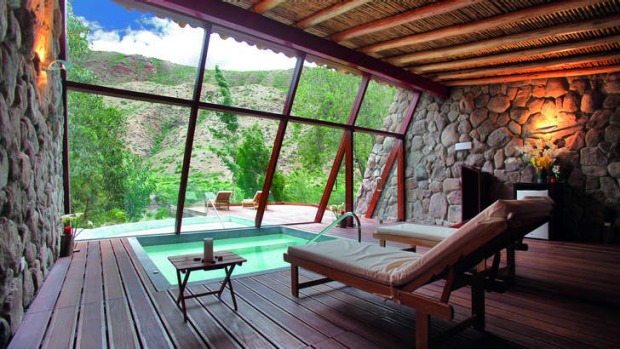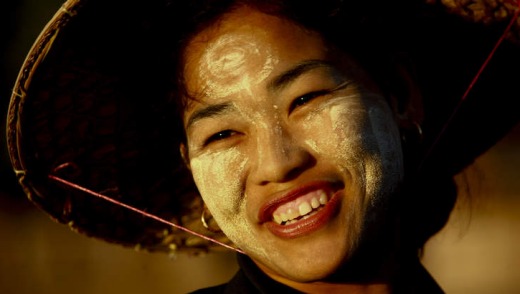
Indigenous treatments are popping up on spa menus around the world, writes Catherine Marshall.
Everywhere I go in Myanmar, I see them: women, children and, on the odd occasion, men, with a clay-like substance swept in neat circles across their cheeks and smudged casually on their noses, chins and foreheads.
I have been into schools in Taunggyi and Loikaw, where children have beamed up at me, their smiles haloed by this creamy paste, to markets in Yangon, where sellers have sat creamy-faced amid mounds of fish and flowers, and to factories in Mandalay and Bagan, where women have squatted around low tables while cutting pieces of gold leaf, their clay swirled faces reflected in the tiny gold squares.

I am intrigued and not sure about the etiquette of inquiring what this substance is.
Finally, I ask a woman what she has put on her face. "Thanaka," she says, smiling shyly, paste wrinkling around her mouth.
"It makes us beautiful."
Thanaka, it transpires, is a miracle treatment that would give Clinique a run for its money: made from ground tree bark, it is used by locals not only to smooth and purify their skin, but as a sunscreen and a cool compress during the famously hot Myan marese weather.
The increasing number of foreign visitors to Myanmar are so fascinated that spas are now adding thanaka to their menus.
Hopeful about its magical properties, I book a thanaka facial at the Princess Heritage's Spa at Inle Princess Resort.
I can imagine miracles being wrought here: the spa is set as if in paradise, among wild mango, acacia and flame trees at the edge of the shimmering Inle Lake.
Behind it are endless rice fields and the benign, looming Shan mountain range.
It was here that the ancient Shan people blended meditation, spirituality and herbal ceremonies in the pursuit of spiritual and bodily purity, and these customs are continued today by the people who live on and around the lake.
Dressed now in a gown and slippers, I sip on a tea of cloves, anise, cardamom, liquorice and sticky rice leaf and amled to a teak framed pavilion, where a therapist clad in a traditional longyi gets to work, cleansing and massaging my face with milk and painting on a thick paste of thanaka.
The effect is instantaneous: the thanaka causesmy skin to tingle dramatically and Iwonder as I lie beneath the palm-leafed roof whether I'll be sporting a red face to dinner tonight. But my concerns are unfounded; once the mask is removed, my skin feels smooth and radiant, every cell seeming to pop with clarity and vigour.
This beautifying procedure will be short-lived, of course, unless I find a pot of thanaka at the market and take it home with me.
As I turn to leave, the therapist delivers a parting gift, a smudge of thanaka upon each cheek.
The facial is part of a global trend in which indigenous treatments are increasingly making an appearance on spa menus. Guests can now indulge in therapies that are drawn from ancient rituals and concoctions, and, in many cases, have been passed on to therapists by local healers and medicine men.
For many travellers, this is an extension of the commitment to "go local "when in a new country: eating ethnic food, buying locally made trinkets, indulging in spa treatments peculiar to their holiday destination.
Instead of booking standard Swedish or Thai treatments, sybarites can take immersion travel to the limit by trying out lomilomi massage in Hawaii, zoku shin do – an ancient form of foot massage – in China, or cactus flower wraps in Arizona.
See inleprincessresort.net.
THE SPA AT THE DARLING
Sydney
Kodo massage – named for the word "melody" in the Meriam Mir language of people of Torres Strait – begins with the lighting of a boorana smoking stick filled with wild-harvested o'yarrang, paperbark, and leaves and essential oil from the native lemon myrtle tree.
Australian desert salt and oils of lemon myrtle and Tasmanian lavender are used in the scrub and- massage process.
The gentle vibrations employed by the masseuse are meant to send one into a trance-like state, while the final pulling of two roughly textured coolamon sticks (traditionally used by Aboriginal women) across the skin reawaken the body and mind.
See star.com.au.
SIGNATURE INDIGENOUS RITUALS
The Oberoi Spa, Gurgaon, India
The three-hour Journey to India includes traditional Indian treatments such as padabhyanga (foot massage), marma facial therapy, Indian scalp massage and an Indian bathing ritual.
Based on the principles of Ayurveda, an ancient ritual defined by natural strokes and movements, the treatments use oils that have been determined by the therapist to best suit the guest's dosha, or body type.
Oils with unfamiliar names – fata, pitta, kapha – are supplemented with liberal doses of turmeric oil.
See oberoihotels.com.
SPA MAYU WILKA
Hotel Rio Sagrado, Urubamba, Peru
The healing powers of Incans and shamans are channeled at this spa in the Sacred Valley of the Incas, through which pilgrims pass on their way to Machu Picchu.
The sacred Andean coca leaf – which visitors are encouraged to drink as a tea infusion toward off altitude sickness – is used as a body wrap to increase energy; Maras salt, mined nearby and dried in terraces up and down the Andean mountainsides, is combined with sacha inchi, an Incan plant with peanut-like seeds, and used as a body scrub; and an altitude acclimatiser massage is said to rid the traveller of the unpleasant side-effects of sudden elevation.
See riosagrado.com.
SPA AT BLYTHSWOOD SQUARE
Glasgow, Scotland
The spa uses an indigenous Scottish skincare range, ishga, made from seaweed hand harvested from the waters around the Isle of Lewis in the Outer Hebrides and saltwater scooped from the waves that break on the island's shores.
Keeping with the theme, the spa offers wholly local treatments: hot stone massage that combines basalt – the rock that undergirds the Hebrides – and Scottish seaweed oil; baths infused with seaweed and mineral sea salts; Hebridean salt scrubs and enveloping seaweed wraps.
If it all feels a bit fishy, guests just need to lie back and think of the Scots, who have been polishing their complexions with vitamin rich seaweed for centuries.
See townhousecompany.com/blythswoodsquare.